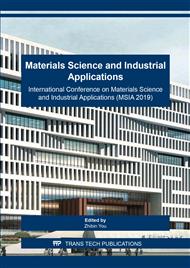[1]
V. Nagarajan, A.K. Mohanty, M. Misra, Perspective on polylactic acid (PLA) based sustainable materials for durable applications: Focus on toughness and heat resistance, ACS Sustainable Chem. Eng. 4 (2016) 2899-2916.
DOI: 10.1021/acssuschemeng.6b00321
Google Scholar
[2]
C. Zhang, W. Wang, Y. Huang, Y. Pan, L. Jiang, Y. Dan, Y. Luo, Z. Peng, Thermal, mechanical and rheological properties of polylactide toughened by expoxidized natural rubber, Mater. Des. 45 (2013) 198-205.
DOI: 10.1016/j.matdes.2012.09.024
Google Scholar
[3]
Y. Wang, K. Chen, C. Xu, Y. Chen, Supertoughened biobased poly(lactic acid)−epoxidized natural rubber thermoplastic vulcanizates: Fabrication, co-continuous phase structure, tnterfacial in situ compatibilization, and toughening mechanism, J. Phys. Chem. B 119 (2015) 12138-12146.
DOI: 10.1021/acs.jpcb.5b06244
Google Scholar
[4]
V.H. Sangeetha, T.O. Varghese, S.K. Nayak, Toughening of polylactic acid using styrene ethylene butylene styrene: Mechanical, thermal, and morphological studies, Polym. Eng. Sci. 56 (2016) 669-675.
DOI: 10.1002/pen.24293
Google Scholar
[5]
Y. Chen, D. Yuan, C. Xu, Dynamically vulcanized biobased polylactide/natural rubber blend material with continuous cross-linked rubber phase, ACS Appl. Mater. Interfaces 6 (2014) 3811-3816.
DOI: 10.1021/am5004766
Google Scholar
[6]
S.W. Lim, M.C. Choi, J.H. Jeong, E.Y. Park, C.S. Ha, Toughening poly(lactic acid) (PLA) through in situ reactive blending with liquid polybutadiene rubber (LPB), Compos. Interfaces, 23 (2016) 807-818.
DOI: 10.1080/09276440.2016.1175168
Google Scholar
[7]
S.Y. Gua, K. Zhang, J. Ren, H. Zhan, Melt rheology of polylactide/poly(butylene adipate-co-terephthalate) blends, Carbohydr. Polym. 74 (2008) 79-85.
DOI: 10.1016/j.carbpol.2008.01.017
Google Scholar
[8]
E.J. Dil, P.J. Carreau, B.D. Favis, Morphology, miscibility and continuity development in poly(lactic acid)/poly(butylene adipate-co-terephthalate) blends, Polymer 68 (2015) 202-212.
DOI: 10.1016/j.polymer.2015.05.012
Google Scholar
[9]
M. Akramia, I. Ghasemi, H. Azizi, M. Karrabi, M. Seyedabadi, A new approach in compatibilization of the poly(lactic acid)/thermoplastic starch (PLA/TPS) blends, Carbohydr. Polym. 144 (2016) 254-262.
DOI: 10.1016/j.carbpol.2016.02.035
Google Scholar
[10]
V. Jašo, M. Cvetinov, S. Rakić, Z.S. Petrović, Bio-plastics and elastomers from polylactic acid/thermoplastic polyurethane blends, J. Appl. Polym. Sci. 131 (2014) 41104.
DOI: 10.1002/app.41104
Google Scholar
[11]
N. Bitinis, R. Verdejo, E.M. Maya, E. Espuche, P. Cassagnau, M.A. Lopez-Manchado, Physicochemical properties of organoclay filled polylactic acid/natural rubber blend bionanocomposites, Compos. Sci. Technol. 72 (2012) 305-313.
DOI: 10.1016/j.compscitech.2011.11.018
Google Scholar
[12]
T. Nazari, H. Garmabi, A. Arefazar, Effect of clay modification on the morphology and the mechanical/physical properties of ABS/PMMA blends, J. Appl. Polym. Sci. 126 (2012) 1637-1649.
DOI: 10.1002/app.36953
Google Scholar
[13]
T. Nazari, H. Garmabi, Effect of organoclays on the rheological and morphological properties of poly(acrylonitrilebutadiene-styrene)/poly(methyl methacrylate)/clay nanocomposites, Polym. Compos. 33 (2012) 1893-1902.
DOI: 10.1002/pc.22329
Google Scholar
[14]
M. Yousfi, J. Soulestin, B. Vergnes, M. F. Lacrampe, P. Krawczak, Morphology and mechanical properties of PET/PE blends compatibilized by nanoclays: Effect of thermal stability of nanofiller organic modifier, J. Appl. Polym. Sci. 128 (2013) 2766-2778.
DOI: 10.1002/app.38450
Google Scholar
[15]
M. Bijarimi, S. Ahmad, R. Rasid, Mechanical, thermal and morphological properties of poly(lactic acid)/natural rubber nanocomposites, J. Reinf. Plast. Compos. 32 (2013) 1656-1667.
DOI: 10.1177/0731684413496487
Google Scholar
[16]
M. Nofar, M.C. Heuzey, P.J. Carreau, M.R. Kamal, Effects of nanoclay and its localization on the morphology stabilization of PLA/PBAT blends under shear flow, Polymer 98 (2016) 353-364.
DOI: 10.1016/j.polymer.2016.06.044
Google Scholar


